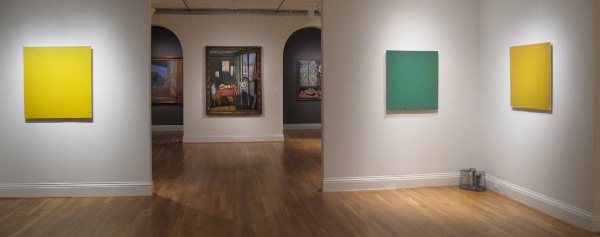Tag Archives: 90 Years of New
Eye to Eye with Pollen and Egg Yolk

Joseph Marioni, Yellow Painting, 2003, No. 9. Acrylic and linen on stretcher 36 x 34 in. Photo: Charles Abdoo
On a recent Spotlight Tour, Joseph Marioni’s bright canvases left many in the group cold. Responses ranged from a resolute “not interested” to a searching, “what do they add to the history of art?” Gallery Educator Alice Shih pointed out that, for some, Joseph Marioni‘s paintings may be best brought into focus by the work of other artists hanging nearby. Alice pointed out sight lines from Marioni to Matisse, to Kandinsky, and along a river of blues and pinks in Gene Davis, to Morris Louis, Adolph Gottlieb, diving into two deep blue Marionis a few galleries beyond.
Alice built further context through metaphor. She told us that the feeling of “egg yolk” pops into her head when she looks at a particular yellow painting by Marioni. (I see pollen, which leads me to the work of another artist recently at the Phillips–Wolfgang Laib).
Later I asked Alice if this kind of color association happens for her with other works by Marioni. She shared this list:
*Red Painting (2002): lava
*Yellow Painting, (2011): the song Good Day Sunshine by The Beatles
*Blue Painting (1995): the night sky (it has spotty moments when it could seem like stars)

Joseph Marioni, Blue Painting, 1995, No. 26. Acrylic and linen on stretcher 28 x 24 in. Photo: Nicholas Walster
Does Marioni’s work bring up particular memories, sensations, references, or metaphors for you? Please comment and let us know.
Cecilia Wichmann, Publicity and Marketing Manager
Congenial Spirits: Matisse and Marioni
At first glance you may not consider the curatorial placement of Joseph Marioni’s Yellow Painting (2003) and Green Painting (2002) flanking Henri Matisse’s Studio, Quai Saint-Michel (1916) in the next gallery. But look again . . .

Henri Matisse's Studio, Quai Saint-Michel (1916) on view in the gallery just beyond Joseph Marioni's green and yellow paintings. Photo: Sarah Osborne Bender
When standing and simultaneously viewing all three paintings from a distance, the shared palette becomes very apparent. Marioni’s paintings begin to vibrate against the walls. The green and yellow echo the edges of the Studio window and ceiling. The red tapestry under Matisse’s Italian model, Lorette, suddenly comes to life. Marioni’s rectangular canvases mimic the window panes that captured the view onto Quai Saint-Michel. In our galleries, rather than peering out on the Seine or the palace of Justice, we look further into the layers and depths of color.
On a tour at the Phillips in October, the artist expressed the significance of Matisse in the installation, describing Studio, Quai Saint-Michel as a “key piece.” According to Marioni, Matisse was one of the first artists to champion early modern color, the emotional context of color as well as the shift from representation to abstraction.
Alice Shih, Gallery Educator

